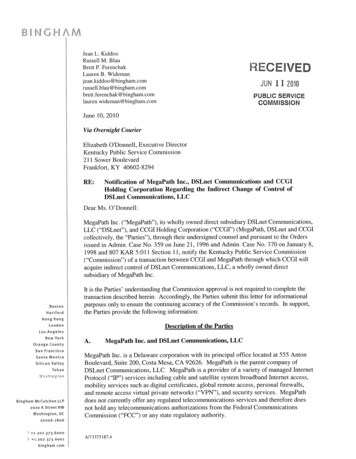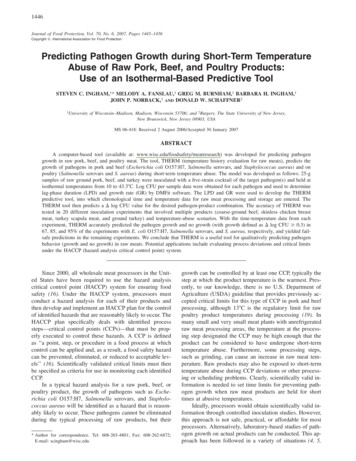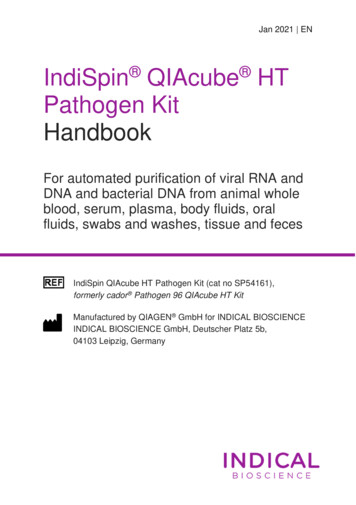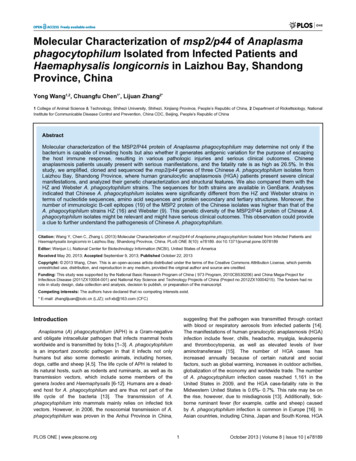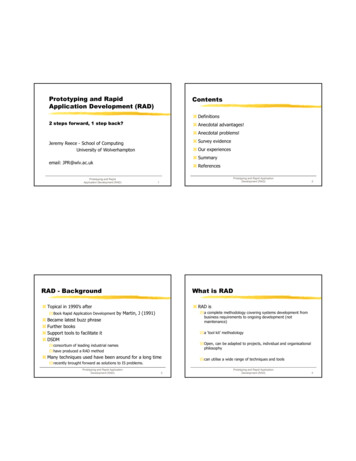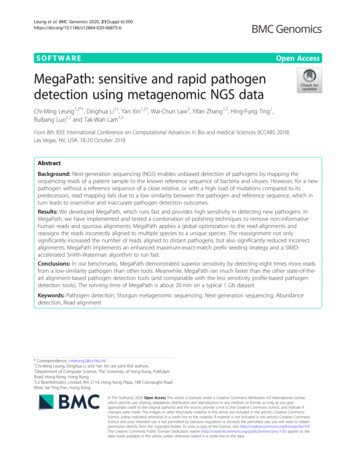
Transcription
Leung et al. BMC Genomics 2020, 21(Suppl FTWAREOpen AccessMegaPath: sensitive and rapid pathogendetection using metagenomic NGS dataChi-Ming Leung1,2*†, Dinghua Li1†, Yan Xin1,2†, Wai-Chun Law2, Yifan Zhang1,2, Hing-Fung Ting1,Ruibang Luo1,2 and Tak-Wah Lam1,2From 8th IEEE International Conference on Computational Advances in Bio and medical Sciences (ICCABS 2018)Las Vegas, NV, USA. 18-20 October 2018AbstractBackground: Next-generation sequencing (NGS) enables unbiased detection of pathogens by mapping thesequencing reads of a patient sample to the known reference sequence of bacteria and viruses. However, for a newpathogen without a reference sequence of a close relative, or with a high load of mutations compared to itspredecessors, read mapping fails due to a low similarity between the pathogen and reference sequence, which inturn leads to insensitive and inaccurate pathogen detection outcomes.Results: We developed MegaPath, which runs fast and provides high sensitivity in detecting new pathogens. InMegaPath, we have implemented and tested a combination of polishing techniques to remove non-informativehuman reads and spurious alignments. MegaPath applies a global optimization to the read alignments andreassigns the reads incorrectly aligned to multiple species to a unique species. The reassignment not onlysignificantly increased the number of reads aligned to distant pathogens, but also significantly reduced incorrectalignments. MegaPath implements an enhanced maximum-exact-match prefix seeding strategy and a SIMDaccelerated Smith-Waterman algorithm to run fast.Conclusions: In our benchmarks, MegaPath demonstrated superior sensitivity by detecting eight times more readsfrom a low-similarity pathogen than other tools. Meanwhile, MegaPath ran much faster than the other state-of-theart alignment-based pathogen detection tools (and compariable with the less sensitivity profile-based pathogendetection tools). The running time of MegaPath is about 20 min on a typical 1 Gb dataset.Keywords: Pathogen detection, Shotgun metagenomic sequencing, Next generation sequencing, Abundancedetection, Read alignment* Correspondence: cmleung2@cs.hku.hk†Chi-Ming Leung, Dinghua Li and Yan Xin are joint first authors.1Department of Computer Science, The University of Hong Kong, PokfulamRoad, Hong Kong, Hong Kong2L3 Bioinformatics Limited, Rm 2114, Hong Kong Plaza, 188 Connaught RoadWest, Sai Ying Pun, Hong Kong The Author(s). 2020 Open Access This article is licensed under a Creative Commons Attribution 4.0 International License,which permits use, sharing, adaptation, distribution and reproduction in any medium or format, as long as you giveappropriate credit to the original author(s) and the source, provide a link to the Creative Commons licence, and indicate ifchanges were made. The images or other third party material in this article are included in the article's Creative Commonslicence, unless indicated otherwise in a credit line to the material. If material is not included in the article's Creative Commonslicence and your intended use is not permitted by statutory regulation or exceeds the permitted use, you will need to obtainpermission directly from the copyright holder. To view a copy of this licence, visit http://creativecommons.org/licenses/by/4.0/.The Creative Commons Public Domain Dedication waiver ) applies to thedata made available in this article, unless otherwise stated in a credit line to the data.
Leung et al. BMC Genomics 2020, 21(Suppl 6):500BackgroundDetecting pathogens such as bacteria or viruses thatcause infections such as pneumonia and meningitis is animportant step in clinical diagnosis. One problem indetecting pathogens is that traditional methods of pathogen detection are time-consuming, as an infectiousdisease may be caused by a large range of pathogens,which have to be checked one by one. Another problemis that up to 60% of the pathogens in some infectiousdiseases cannot be detected [1]. This can cause a delayin treatment or even mistreatment of patients.Unbiased next-generation sequencing (NGS) can detect DNA fragments (reads) of all species in a metagenomic sample with a mixture of different species. ThoseNGS reads can be classified into different taxa by comparing them with a collection of reference sequences,and pathogens can be detected if some reads matchthem. In clinical diagnoses, it is essential that a classifiercan detect a significant number of reads supporting thepotential pathogens and report as few false classificationsas possible to give a high abundance rank to the pathogen. Otherwise, the pathogen cannot be distinguishedfrom background noise, and it will take doctors a longtime to go through a long list of candidates to dig out itsexistence.Existing metagenomic classifiers are not effective fordetecting low-similarity pathogens, i.e., pathogen with agenome that is not similar to the reference. This is because most classifiers detect pathogens by constructing acharacteristic profile (e.g., k-mers) for each referenceand assigning reads to species by comparing them withthe reference profiles [2, 3]. When the characteristic profile does not match the genome of low-similarity pathogens, this approach fails and results in many incorrect ornon-specific classifications.Some tools assign reads to reference sequences bylocal or semi-global alignment. Using an alignmentbased method, more reads can be assigned to the causalpathogen, but at the cost of much longer analysis time(over 4 h for a typical 1 Gb dataset). However, the alignment score of reads from a low-similarity pathogen isconceivably low, and these reads often cannot beassigned to the causal pathogen specifically, so thenumber of reads supporting the causal pathogen is stilltoo low.To detect low-similarity pathogens, we developedMegaPath for NGS-based pathogen detection. It has twosignificant contributions. First, instead of assigning eachread to a reference sequence one by one, MegaPathanalyzes all aligned reads globally to sort out a subset ofreads with confident alignments. Then, MegaPathreassigns the non-specifically aligned reads to the specieswith confident alignments and discards spuriousalignments to avoid potential false classifications. ThePage 2 of 9reassignment increases the number of reads supportingthe causal pathogens and reduces the number of falsepositive assignments. Second, MegaPath implements afast alignment-based approach, utilizing an enhancedmaximum-exact-match prefix seeding strategy and aSIMD-accelerated Smith-Waterman algorithm.Let us take a metagenomic NGS sample of cerebrospinal fluid [4] as an example. The similarity of thepathogen to reference is 18.9%. Centrifuge [2], CLARK[5] and Kraken [3], based on characteristic profile, detected 31, 1 and 6 reads from the pathogen, respectively.The abundance rank of the pathogen was 710, 1488 and384, respectively. With that, a medical doctor needs togo through a list of hundreds of species to reach thecausal pathogen. Kraken2 [3] is the successor of Krakenthat applies more sophisticated characteristic profiles. Itdetected 74 reads from the pathogen and the abundancerank of the pathogen went up to 176. SURPI [6] spentfour hours on read alignment and detected 76 readsfrom the pathogen, abundance rank at 264. In contrast,with better alignment tools and global analysis of reads,MegaPath took less than one hour and detected 608reads for the pathogen, abundance rank at 33. In ourexperiment, MegaPath performed better than the existing tools, ran faster than the alignment-based tools andhas comparable running time with the less sensitivityprofile-based tools.In addition to detecting pathogens with known reference sequences, MegaPath can detect novel pathogenswithout any similar DNA-level sequences in the reference database. MegaPath uses MegaHit [7] to assemblethe reads from the novel pathogens to longer DNA fragments. Since protein sequences are better-conservedthan DNA sequences [8, 9], these DNA contigs fromnovel pathogens are then annotated by DNA-proteinalignment [10] to detect related species, genera orfamilies.ImplementationFigure 1 shows the workflow of MegaPath. There arethree major steps in MegaPath for detecting pathogens.First, it applies MegaGuide, an ultrafast NGS alignerspecifically designed for pathogen detection to alignreads to reference sequences of bacteria and viruses.Then it applies spike polishing to filter spuriousalignments at highly repeated regions. Lastly, it applies atwo-phase taxonomy assignment of reads.Aligning reads with MegaGuideMegaGuide is an ultra-fast aligner that follows a seedand-extend procedure. In the seeding stage, MegaGuidesearches for maximum-mappable seeds in the read usinga BWT built from the reference sequences. The searchwill stop at (or a few bases after) a sequencing error or a
Leung et al. BMC Genomics 2020, 21(Suppl 6):500Page 3 of 9Fig. 1 The workflow of MegaPathgenomic mutation. A new search will start at the end ofthe previous seed. The maximum-mappable seedingstrategy reduces a vast number of short seeds that cannot be used to find the true alignments. The overlap between the seeds boosts sensitivity, especially for distantspecies. In the extension stage, MegaGuide implementsan improved Smith-Waterman algorithm with eachentry in the dynamic programming tables using 8 bits orless (instead of the normal implementation using 64bits). Thus, by applying the 256-bit SIMD instructions,values of 32 entries can be calculated in parallel.The reference database is large (the size of the latestRefSeq is over 30 Gb). It is neither efficient nor necessaryto align all reads to all reference sequences. Thus, the following two types of reads, which are not informative forpathogen detection, will be filtered out from the downstream analysis. First, clinical metagenomic samples areusually dominated with human DNA (which could be ashigh as 95%) that carries no pathogen information. Second, short NGS reads sampled from the repetitive orhomologous regions across species, e.g., ribosomal DNA,are not useful for pathogen detection. MegaPath filtersout the two types of reads by aligning reads to the humanreference genome and a database of homologous regions.Reads confidently aligned to the human reference genomeor the homologous regions will be removed. Theremaining reads will then be aligned to the pathogen genome database for pathogen detection.Spike polishingAligning reads to human genome or homologousregions can detect most of the reads that are not informative for pathogen detection. However, not all of themcan be detected due to the missing annotation or theincomplete classification of all possible homologousregions. To filter out reads sampled from unknownhomologous regions, MegaPath makes use of the readdepth information of each genome. Since MegaGuidealigns a read to all its possible genome positions, theread depth of the homologous regions is expected to bemuch higher than the other regions. MegaPath calculates the mean (u) and the standard deviation (sd) of theread depth of each genome. Continuous regions with aread depth higher than u α·sd are defined as spikeregions. All alignments in the spike regions will beremoved from the downstream analysis. We have triedthe value of α from 1 to 100. When α 10, there aremany regions misidentified as spike regions and areremoved. When α 50, only a few spike regions weredetected and many homologous regions remain. Thefiltering has the best performance for α being from 10 to50. Thus, we select α 30 as default.The two-stage taxonomy assignment algorithmIt is common that a read is aligned to different genomeswith the same (or similar) confidence. These genomesmay be from different species, genus, or even families. A
Leung et al. BMC Genomics 2020, 21(Suppl 6):500straightforward way to assign a read to a taxon is assigning it to the lowest common ancestor (LCA) of all taxathe read aligned to. However, this approach leads to alarge number of less specific assignments. MegaPathimplements a two-stage assignment algorithm to increase the specificity. In the first stage, MegaPath assignseach read to the species they aligned to. We allow a readto be assigned to multiple species because the sequencedpathogen might have enriched mutations in some regions, and these regions can look very different from thecorrect reference genome. After assigning all the reads,in the second stage, MegaPath will try to reassign eachof the shared reads to a species using the followingrules.First, all reads are assigned to one or more speciesaccording to their alignments. A read is tagged by ‘U’ ifit is assigned to only one species, or ‘M’ if assigned tomore than one species. Then, for each species, the numbers of ‘U’-tagged reads and the number of ‘M’-taggedreads are calculated. For a species S, we defineUCount(S) as the number of ‘U’-tagged reads assignedto S, and AllCount(S) as the number of both ‘U’-taggedand ‘M’-tagged reads assigned to S. For two species Sand T, we define MCount(S, T) as the number of readsassigned to both S and T. We say a species S weaklyexplains another species T, if 1) AllCount(S) MCount(S, T) r * AllCount(S), and 2) UCount(T) e *UCount(S). The default values of r and e are both0.05. Descriptively, the criteria are interpreted as, 1)reads aligned to S are likely to be correct alignments(instead of misaligning read sampled from T) if quitea number of reads (r 5%) are not similar to T; 2)the unique reads that support T might be a coincidence (e 5%) due sequencing error or misalignment.We say S explains T if S weakly explains T and nospecies weakly explains S.In the second stage, a read assigned to both S and Twill be reassigned to S only if S explains T. Afterreassigning all the shared reads, MegaPath will apply theLCA algorithm to determine the taxon of each read.ResultsReal datasets with known causal pathogens detectedusing traditional methods were used to evaluate the performance of MegaPath, and existing pathogen detectiontools including SURPI [6], Centrifuge [2], CLARK [5],Kraken and Kraken2 [3]. Centrifuge, CLARK, Kraken,and Kraken2 construct a characteristic profile for eachreference sequence and detect the existence of pathogens by comparing the reads to the constructed profiles.Kraken2 rans longer but performs better than its predecessor Kraken because it constructs a more sophisticatedprofile. These tools ran fast, but their sensitivity is not asgood as the alignment-based tools’ for detecting low-Page 4 of 9similarity pathogens. SURPI detects pathogens byaligning reads to the reference sequences. SUPRI as theslowest tool, is generally more sensitive than the profilebased tools. MegaPath, by implementing a fast alignmentstrategy and analyzing the read alignments globally,achieves the highest sensitivity using a reasonableamount of running time.We evaluated the tools using three types of datasets. First, we compared the sensitivity of the tools onreal metagenomic datasets with known pathogens.Second, since the abundance rank of the pathogens inthe real metagenomic datasets is unknown, we evaluated the tools based on mock metagenomic datasetswith known relative abundance. Last, we evaluatedthe sensitivity and false-positive rate of the tools ondetecting pathogens with different similarity to theircorresponding reference sequence using a real cultured dataset.Performance on real metagenomic datasetsNine real metagenomic datasets [4, 11, 12] were usedto evaluate the sensitivity of MegaPath, SURPI [6], Centrifuge [2], CLARK [5], Kraken and Kraken2 [3] on detecting pathogens in real clinical samples. The datasetsinclude cerebrospinal fluid, nasopharyngeal, and serumsample with the pathogen confirmed by conventionalmethods. Datasets 1 and 3 are two metagenomic NGSsamples of cerebrospinal fluid (CSF) and nasopharyngeal (NP) swabs [4]. Datasets 2, 6, and 7 are plasmasamples spiked with different concentrations of HIV[6]. Datasets 4, 5, 8, and 9 are HCV- or HBV-infectedhuman livers [11].Table 1 shows the number of reads and the abundancerank of the pathogen detected by each tool, sorted in increasing order of similarity between the pathogen genome and the reference sequence. Using BLASTn [13] asthe aligner, the similarity is measured by the number ofreads sampled from the pathogen that were aligned tothe reference sequence against the number of reads sampled from the pathogen. Since the number of reads fromthe pathogen is unknown in the real dataset, we usedthose reads detected by the multiple tools as a rough estimation. Table 1 shows that when the pathogen genomeis similar to the reference sequence (datasets 6 to 9), alltools performed quite well, except for dataset 7, in whichthe abundance of the pathogen is very low. For thosedatasets in which the pathogen genome is varied fromthe reference sequence (datasets 1 to 5), although mostof the tools have detected more or less a few reads fromthe pathogen, the numbers were too low to tell apart thepathogen from the background noise, especially forthose profile-based tools. Use dataset 1 as an example,Centrifuge, CLARK, and Kraken detected 31, 1, and 6reads, respectively. The abundance rank of the pathogen
Leung et al. BMC Genomics 2020, 21(Suppl 6):500Page 5 of 9Table 1 Benchmarking results of the pathogen detection tools on nine real metagenomic athSURPICentrifugeCLARKKrakenKraken218.9%33 (608)264 (76)710 (31)1.5 K (1)384 (6)176 (74)rank (# read)1Enterovirus D2Human immunodeficiency virus19.0%15 (3.8 K)63 (1.0 K)78 (1.3 K)69 (444)109 (216)32 (1.4 K)3Enterovirus D27.9%622 (202)788 (50)2.5 K (14)2.6 K (8)1.3 K (9)1.5 K (17)4Hepatitis C virus36.3%2 (12 K)2 (7.4 K)65 (2.9 K)15 (2.5 K)3 (2.4 K)31 (4.2 K)5Hepatitis C virus38.4%2 (568)6 (374)379 (150)152 (182)12 (130)231 (218)6Human immunodeficiency virus43.9%3 (54 K)5 (21 K)6 (16 K)4 (13 K)6 (4.5 K)2 (18 K)7Human immunodeficiency virus46.1%187 (41)421 (19)859 (18)430 (18)n/a (0)496 (19)8Hepatitis B virus69.4%2 (43 K)2 (33 K)18 (19 K)4 (20 K)3 (19 K)7 (20 K)9Hepatitis B virus72.8%2 (3.0 K)4 (2.4 K)191 (1.5 K)41 (1.5 K)4 (1.1 K)94 (1.5 K)was 710, 1488, and 384, respectively (a doctor will haveto go through a list of over 300 candidate species to digout the pathogen). Kraken2 outperformed its predecessor and detected 74 reads from the pathogen, with anabundance rank at 176. SURPI spent over four hours onread alignment and detected 76 reads for the pathogen,with an abundance rank at 264. Notably, MegaPath tookless than one hour and detected 608 reads for the pathogen, with an abundance rank at 33. MegaPath performedthe best among the existing tools but ran much fasterthan other alignment-based tools. Worth mentioning,the reference sequences of the low similarity EnterovirusD in dataset 1 and 3 were drafted and were just recentlyaccepted to NCBI. We expect the performance ofMegaPath as well as other tools will further improveusing updated NCBI databases with more completereference sequences.Performance on mock metagenomic datasetsThe abundance rank of the pathogen is unknown in realmetagenomic datasets. So in addition, we evaluated theperformance of the tools using a mock metagenomicdataset, which was generated by mixing NGS reads from3 real datasets: 1) 95% reads from a human sample(NA12878), 2) 4.75% (5% 95%) reads from a metagenomic dataset with ten species with known abundance[14], and 3) 0.25% (5% 5%) reads from a spikedbacteria. Since the reads from the species are known, theabundance rank of the spiked bacteria was determinedas rank 4. Bacteria that have different similarities to theirreference sequences were tested and the results areshown in Table 2.With high similarity between the bacteria and the reference sequence (datasets 5 to 12), most tools detectedthe spiked bacteria in the top 30 species. However, theabundance rank detected by other tools was incorrect.MegaPath detected the correct rank (rank 4 for datasets7 to 12) or a close rank (rank 6 for datasets 5 and 6) forthe spiked bacteria. A possible explanation is that othertools discard or randomly assign the reads without aunique alignment, which leads to error in the abundancerank. However, MegaPath analyzes all aligned readsglobally and assigns the non-uniquely aligned readsbased on reads that are confidently aligned, leading to amore accurate abundance rank. For low-similaritybacteria (datasets 1 to 4), the amount of non-uniquealignments increased. Other tools failed or detected thebacteria with low abundance ranks. In contrast, MegaPath detected the spiked bacteria within the top 14species.We also evaluated the sensitivity, precision, and F1score of the tools on the mock metagenomic dataset.The results are shown in Table 3. Since we know theorigin of each read – from the human, the mockcommunity or the spiked bacteria, a true positive isdefined as a read being assigned correctly to itsorigin. Among the results, MegaPath achieved thehighest sensitivity, precision, and F1 score. SURPI hasbeen left out in Table 3, because it filtered out readswithout annotation, making us unable to get thenumber of false-negative reads.Sensitivity and FDR on mutated speciesSince the real assignment to an exact species of an individual read is unknown in the real metagenomic datasetsand the mock metagenomic dataset, thus it is unsuitablefor evaluating the false discovery rate (FDR) of the tools.To evaluate the FDR of the tools, we have done an experiment on 139 NGS datasets of cultured isolated bacteria [2] where 1) all reads in each dataset are supposedto come from a single bacteria, and 2) the similaritiesare between 20 and 90%. According to the benchmarksin the previous two sections, we only benchmarked thetwo best performing tools Centrifuge and MegaPath inthis section.
Leung et al. BMC Genomics 2020, 21(Suppl 6):500Page 6 of 9Table 2 Benchmarking results of the pathogen detection tools on a mock metagenomic occus hirae20.6%2Corynebacterium halotolerans3Clostridium botulinum4Corynebacterium falsenii42.1%5Gardnerella vaginalis56.2%6Pasteurella multocida60.4%6 (19.8 K)25 (2.9 K)21 (6.2 K)23 (2.8 K)14 (3.6 K)14 (5.6 K)7Micrococcus luteus73.7%4 (25.5 K)14 (24.7 K)10 (17.2 K)13 (12.6 K)11 (16.6 K)11 (16.9 K)1Spiked bacteriaSURPICentrifugeCLARKKrakenKraken213 (579)96 (123)18 (7.3 K)386 (74)65 (315)83 (207)29.6%14 (526)n/a (0)241 (331)457 (58)80 (205)77 (220)38.3%8 (1.7 K)62 (260)65 (1.5 K)108 (465)65 (304)37 (625)9 (1.2 K)n/a (0)208 (403)n/a (0)85 (192)61 (328)6 (20.2 K)23 (7.3 K)14 (9.7 K)17 (4.9 K)13 (4.7 K)14 (6.6 K)rank (# read)8Gallibacterium anatis75.8%4 (37.4 K)11 (34 K)10 (17.8 K)12 (18.3 K)11 (17.7 K)11 (18 K)9Citrobacter freundii77.6%4 (38.5 K)14 (21.4 K)8 (27.2 K)13 (10.4 K)11 (18.6 K)12 (18.6 K)10Haemophilus parainfluenzae85.8%4 (38.7 K)n/a (0)10 (18.0 K)12 (20.2 K)11 (17.4 K)11 (18.8 K)11Leuconostoc gasicomitatum91.6%4 (39.0 K)10 (38.4 K)9 (21.8 K)11 (22.6 K)11 (21.4 K)11 (21.5 K)12Human campylobacteriosis95.6%4 (34.6 K)13 (28.1 K)8 (30.6 K)12 (19.0 K)11 (19.2 K)11 (18.4 K)Figure 2 has shown the sensitivity (a) and FDR (b)of Centrifuge and MegaPath on each dataset forassigning reads to the known isolated bacteria. At thesame similarity, higher sensitivity and lower FDR areexpected. As shown, MegaPath consistently outperformed Centrifuge. Both the sensitivity and FDR ofthe two tools were close at higher similarities. However, at lower similarities, MegaPath achieved highersensitivities and lower FDRs.Time consumption on real metagenomic datasetsThe time complexities of the profile-based tools and thealignment-based tools are different. Profile-based toolsincluding Centrifuge, CLARK, Kraken, and Kraken2,have a time complexity of O(n ts), where n is the totalnumber of bases of the input reads, t is the number ofthe input reads, and s is the number of species in the input database. Alignment-based tools including MegaPathand SURPI, have a time complexity of O (nd), where d isthe maximum allowed edit distance between a read anda reference sequence.To show the real-time consumption of each tool inpractice, we benchmarked all tools using nine real metagenomic datasets. The results are shown in Table 4. Allsoftware tools expect for Kraken2 and CLARK werebenchmarked using two Intel E5–2637 v2 (8 CPU cores)and 96 GB RAM. Kraken2 and CLARK asked for muchmemory, thus they were benchmarked on another fasterTable 3 Sensitivity, precision, and F1-score of the pathogen detection tools on a mock metagenomic datasetDatasetSpiked re (Sensitivity, Precision)1Enterococcus hirae98.5% (97.1, 99.9%)96.2% (92.8, 99.9%)98.0% (96.1, 100%)97.3% (94.8, 99.9%)97.7% (95.6, 99.9%)2Corynebacterium halotolerans98.5% (97.1, 100%)96.3% (92.8, 100%)98.0% (96.1, 100%)97.3% (94.8, 100%)97.8% (95.6, 100%)3Clostridium botulinum98.5% (97.1, 100%)96.3% (92.8, 99.9%)98.0% (96.1, 100%)97.3% (94.8, 100%)97.8% (95.6, 99.9%)4Corynebacterium falsenii98.5% (97.1, 100%)96.3% (92.8, 100%)98.0% (96.1, 100%)97.3% (94.8, 100%)97.8% (95.6, 100%)5Gardnerella vaginalis98.6% (97.2, 100%)96.3% (92.9, 100%)98.0% (96.1, 100%,)97.3% (94.8, 100%)97.8% (95.7, 100%)6Pasteurella multocida98.6% (97.2, 100%)96.3% (92.9, 100%)98.0% (96.1, 100%)97.3% (94.8, 100%)97.8% (95.7, 100%)7Micrococcus luteus98.6% (97.2, 100%)96.4% (93.0, 100%)98.1% (96.2, 100%)97.4% (94.9, 100%)97.8% (95.8, 100%)8Gallibacterium anatis98.6% (97.3, 100%)96.4% (93.0, 100%)98.1% (96.2, 100%)97.4% (95.0, 100%)97.8% (95.8, 100%)9Citrobacter freundii98.5% (97.2, 99.9%)96.4% (93.0, 99.9%)98.0% (96.2, 99.9%)97.4% (95.0, 99.9%)97.8% (95.8, 99.9%)10Haemophilus parainfluenzae98.6% (97.3, 100%)96.4% (93.0, 99.9%)98.1% (96.3, 100%)97.4% (95.0, 100%)97.8% (95.8, 100%)11Leuconostoc gasicomitatum98.2% (96.6, 100%)96.4% (93.0, 99.9%)98.1% (96.3, 100%)97.4% (95.0, 100%)97.9% (95.8, 100%)12Human campylobacteriosis98.6% (97.3, 100%)96.4% (93.0, 100%)98.1% (96.3, 100%)97.4% (95.0, 100%)97.8% (95.8, 100%)
Leung et al. BMC Genomics 2020, 21(Suppl 6):500Page 7 of 9Fig. 2 (a) Sensitivity and (b) False Discovery Rate (FDR) of Centrifuge and MegaPathmachine with Intel E5–2695 v2 (24 CPU cores, but only8 were used) and 192GB RAM. While the database indices could be reused once built, we did not include thetime for building database indices in Table 4.DiscussionNext-generation sequencing (NGS) has enabled unbiaseddetection of pathogens through mapping the sequencingreads of a patient sample to the known reference sequence of bacteria and viruses. However, existing NGSbased pathogenic detection tools fail to detect lowsimilarity pathogens or usually assign them with a lowrank because the tools fail to assign reads to the reference sequences correctly. In this paper, we introducedMegaPath for detecting these low-similarity pathogens.MegaPath analyzes read alignments globally and uses atwo-phase assignment of reads. We will discuss theperformance of the two-phase assignment design in thissection. Besides, for those novel pathogens without areference sequence, we will discuss how MegaPath candetect them by sequence assembling and how good itsperformance is.Performance of the two-phase assignment of readsAs the mutation rate of bacteria and viruses is high, andthe sequence of some pathogens are unknown, manypathogens are without a similar reference sequence inthe database. Existing pathogen detection tools oftendiscard a read sampled from low-similarity regions orassign the read to an arbitrary position. As a result, alow-similarity pathogen may not be detected or may bedetected at a low abundance rank. To solve the problem,MegaPath applies a two-phase assignment of reads. Toevaluate the performance of the two-phase assignmentdesign, we ran MegaPath with and without a two-phaseassignment on nine real metagenomic datasets.The results are shown in Table 5. In datasets 1, 3, and6, the number of reads assigned to the pathogen increases with the two-phase assignment because severalnon-uniquely aligned reads from low-similarity regionshave been reassigned to the correct pathogen. Twophase assignment not only increases the number ofreads assigned to the correct pathogen, but also reducesfalse-positive alignments. In datasets 2, 4 and 7, althoughthe number of reads assigned to the correct pathogendid not change, the number of false-positive readsTable 4 Time consumption of six tools. SURPI was running in the “comprehensive KKrakenKraken21Enterovirus D48 min4 h 34 min4 min18 min3 min12 min2Human immunodeficiency virus12 min3 h 29 min1 min8 min1 min7 min3Enterovirus D4 h 55 min14 h 57 min9 min22 min28 min13 min4Hepatitis C virus1 h 45 min5 h 13 min3 min10 min12 min6 min5Hepatitis C virus1 h 18 min4 h 6 min3 min14 min10 min9 min6Human immunodeficiency virus26 min3 h 51 min1 min7 min1 min12 min7Human immunodeficiency virus11 min3 h 22 min1 min8 min1 min15 min8Hepatitis B virus58 min5 h 9 min7 min12 min9 min28 min9Hepatitis B virus1 h 4 min4 h 20 min4 min13 min9 min1 h 11 min
Leung et al. BMC Genomics 2020, 21(Suppl 6):500Page 8 of 9Table 5 Benchmarking results of MegaPath with and without a two-phase assignment on nine real metagenomic Path (w/ two-phase assignment)MegaPath (w/o two-phase assignment)rank (# read)1Enterovirus D18.9%33 (608)50 (594)2Human immunodeficiency virus19.0%15 (3.8 K)23 (3.8 K)3Enterovirus D27.9%622 (202)631 (197)4Hepatitis C virus36.3%2 (12 K)4 (12 K)5Hepatitis C virus38.4%2 (568)2 (568)6Human immunodeficiency virus43.9%3 (54.2 K)3 (54.0 K)7Human immunodeficiency virus46.1%187 (41)347 (41)8Hepatitis B virus69.4%2 (43 K)2 (43 K)9Hepatitis B virus72.8%2 (3.0 K)2 (3.0 K)aligned to species with a higher abundance rank is reduced. As a result, the abundance rank of the correctpathogen in
MegaPath for NGS-based pathogen detection. It has two significant contributions. First, instead of assigning each read to a reference sequence one by one, MegaPath analyzes all aligned reads globally to sort out a subset of reads with confident alignments. Then, MegaPath reassigns the non-specifically aligned reads to the species
